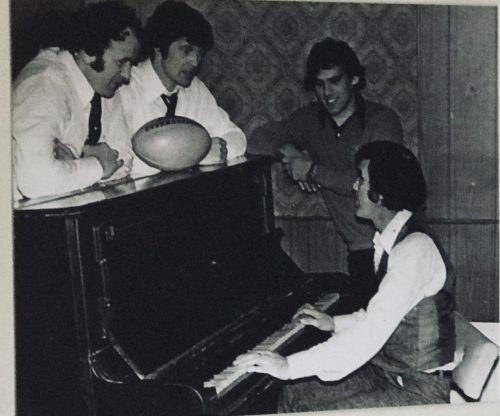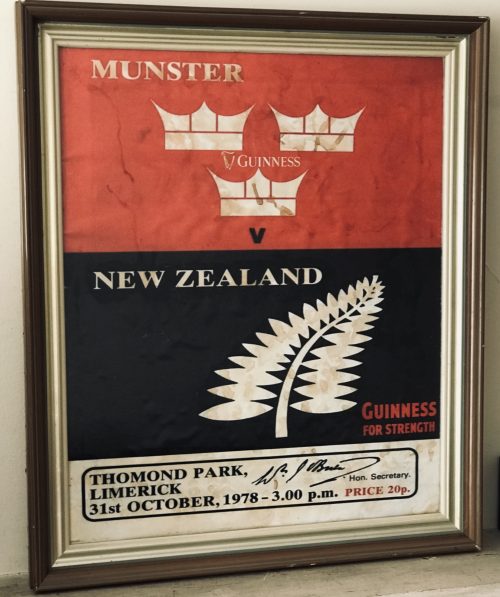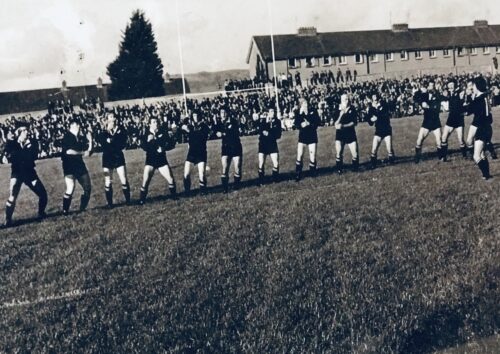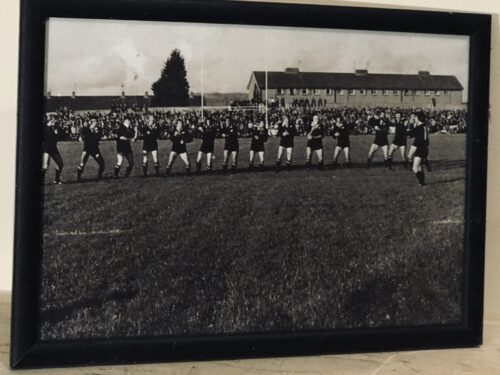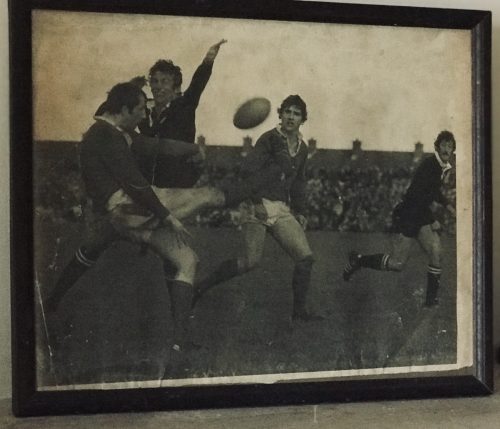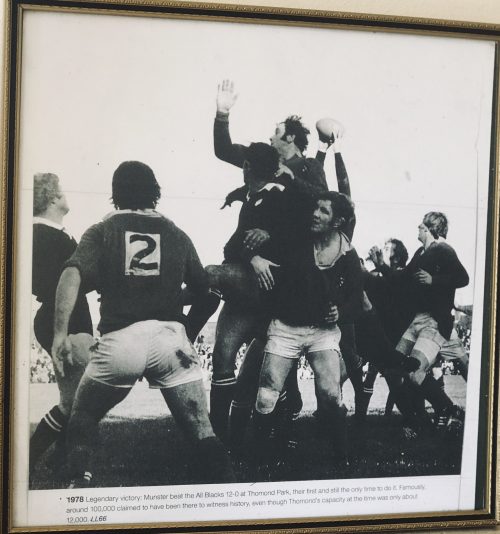Fascinating map from 1610 as by the renowned cartographer John speed of the Province of Mounster(Munster!)-comprising the counties of Tipperary,Clare,Limerick,Cork,Kerry & Waterford.Includes miniature city layouts of both Limerick & Cork.
52cm x 65cm Beaufort Co Kerry
John Speed (1551 or 1552 – 28 July 1629) was an English
cartographer and historian.
He is, alongside
Christopher Saxton, one of the best known English mapmakers of the early modern period.
Life
Speed was born in the
Cheshire village of
Farndon and went into his father Samuel Speed's tailoring later in life.
While working in London, Speed was a tailor and member of a corresponding guild, and came to the attention of "learned" individuals.
These individuals included Sir
Fulke Greville, who subsequently made him an allowance to enable him to devote his whole attention to research. By 1598 he had enough patronage to leave his manual labour job and "engage in full-time scholarship".
As a reward for his earlier efforts,
Queen Elizabethgranted Speed the use of a room in the Custom House. Speed, was, by this point, as "tailor turned scholar" who had a highly developed "pictorial sense".
In 1575, Speed married a woman named Susanna Draper in
London, later having children with her. These children definitely included a son named John Speed, later a "learned" man with a
doctorate, and an unknown number of others, since chroniclers and historians cannot agree on how many children they raised.
Regardless, there is no doubt that the Speed family was relatively well-off.
By 1595, Speed published a map of biblical
Canaan, in 1598 he presented his maps to Queen Elizabeth, and in 1611–1612 he published maps of Great Britain, with his son perhaps assisting Speed in surveys of English towns.
At age 77 or 78, in August 1629, Speed died.
He was buried alongside his wife in London's
St Giles-without-Cripplegate church on
Fore Street.
Later on, a memorial to John Speed was also erected behind the altar of the church.
According to the church's website, "[His was] one of the few memorials [in the church] that survived the bombing" of London during
The Blitz of 1940–1941 ... The website also notes that "[t]he cast for the niche in which the bust is placed was provided by the Merchant Taylors' Company, of which John Speed was a member". His memorial brass has ended up on display in the
Burrell Collection near
Glasgow.
Works
Speed drew historical maps in 1601 and 1627 depicting the invasion of England and Ireland, depictions of the English
Middle Ages, along with those depicting the current time, with rough originals but appealing, colourful final versions of his maps.
It was with the encouragement of
William Camden that Speed began his
Historie of Great Britaine, which was published in 1611.
Although he probably had access to historical sources that are now lost to us (he certainly used the work of
Saxton and
Norden), his work as a historian is now considered secondary in importance to his map-making, of which his most important contribution is probably his
town plans, many of which provide the first visual record of the British towns they depict.
In the years leading up to this point, while his atlas was being compiled, he sent letters to
Robert Cotton, part of the British government to ask for assistance in gathering necessary materials.

In 1627 George Humble published the Prospect of the Most Famous Parts of the World, printed by John Dawson. This is the world map from this atlas with John Speed's name in the title, but not attributed to Speed's authorship.
His atlas
The Theatre of the Empire of Great Britaine was published in 1611 and 1612, and contained the first set of individual county maps of
England and
Wales besides maps of
Ireland and a general map of
Scotland.
Tacked onto these maps was an introduction at the beginning when he addressed his "well affected and favourable reader", which had numerous Christian and religious undertones, admitting that there may be errors, but he made it the best he could, and stated his purpose for the atlas:
my purpose...is to shew the situation of every Citie and Shire-town only [within Great Britain]...I have separated...[with] help of the tables...any Citie, Towne, Borough, Hamlet, or Place of Note...[it] may be affirmed, that there is not any one Kingdome in the world so exactly described...as is...Great Britaine...In shewing these things, I have chiefly sought to give satisfaction to all.
With maps as "proof impressions" and printed from
copper plates, detail was engraved in reverse with writing having to be put on the map the correct way, while speed "copied, adapted and compiled the work of others", not doing much of the survey work on his own, which he acknowledged.
The atlas was not above projections of his political opinions" Speed represented King
James I as one who unified the "Kingdoms of the British isles".
In 2016, the
British Library published a book, introduced by former MP
Nigel Nicolson and accompanied by commentaries by late medieval and early modern historian Alasdair Hawkyard, which reprinted this collection of maps on the British Isles, showing that Speed had drawn maps of areas ranging from
Bedfordshire to
Norfolk and
Wales.
Most, but not all, of the county maps have town plans on them; those showing a
Scale of Passes being the places he had mapped himself. In 1627, two years before his death, Speed published
Prospect of the Most Famous Parts of the World which was the first world atlas produced by an Englishman, costing 40
shillings, meaning that its circulation was limited to "richer customers and libraries", where many survive to this day.
There is a fascinating text describing the areas shown on the back of the maps in English, although a rare edition of 1616 of the British maps has a Latin text – this is believed to have been produced for the Continental market. Much of the engraving was done in
Amsterdam at the workshop of a Flemish man named
Jodocus Hondius, with whom he collaborated with from 1598 until 1612, with Hondius's sudden death, a time period of 14 years.
His maps of English and Welsh counties, often bordered with costumed figures ranging from
nobility to country folk, are often found framed in homes throughout the United Kingdom.
In 1611, he also published
The genealogies recorded in the Sacred Scriptures according to euery family and tribe with the line of Our Sauior Jesus Christ obserued from Adam to the Blessed Virgin Mary, a biblical genealogy, reprinted several times during the 17th century. He also drew maps of the
Channel Islands,
Poland, and
the Americas, the latter published only a few years before his death.
On the year of his death, yet another collection of maps of
Great Britain he had drawn the year before were published.
Described as a "Protestant historian", "Puritan historian" or "Protestant propagandist" by some, Speed wrote about
William Shakespeare, whom he called a "Superlative Monster" because of certain plays, Roman conquest, history of
Chester, and explored "early modern concepts of national identity". As these writings indicate, he possibly saw Wales as English and not an
independent entity. More concretely, there is evidence that Speed, in his chronicling of history, uses "theatrical metaphors" and his developed "historiographic skill" to work while he repeats myths from medieval times as part of his story.
Legacy
Since his maps were used in many high circles, Speed's legacy has been long-reaching. After his death, in 1673 and 1676, some of his other maps on the British isles, the
Chesapeake Bay region, specifically of
Virginia and
Maryland, the
East Indies, the
Russian Empire then ruled by
Peter the Great,
Jamaica, and
Barbados, among other locations.With these printings and others, Speed's maps became the basis for world maps until at least the mid-eighteenth century, with his maps reprinted many times, and served as a major contribution to British
topography for years to come.
In later years, Speed would be called "our English Mercator", a person of "extraordinary industry and attainments in the study of antiques", an "honest and impartial historian", a "faithful Chronologer", and "our Cheshire historian...a scholar...a distinguished writer on history".
He was also called a "celebrated chronologer and histographer", "cartographer", and much more.
Even today, prints of his "beautiful maps" can be found in living rooms across the world, and sell for hundreds of thousands of pounds in rare art and map auctions, drawing in map collectors across the globe.
Additionally, some use John Speed's maps, and connected commentary, to interpret William Shakespeare's plays; however, Speed did not like Shakespeare in the slightest, and called him a "papist".
 The 1938 All-Ireland Football Final Replay on October 23rd, 1938 ended in the most bizarre fashion imaginable when with 2 minutes left to play, Galway supporters, mistakenly believing the referee had blown for full-time, invaded the pitch, causing a 20 minute delay before the final minutes could be played out.
Even more dramatic was the fact that by the time the pitch was cleared, most of the Kerry players seemed to have disappeared.
The 1938 All-Ireland Football Final Replay on October 23rd, 1938 ended in the most bizarre fashion imaginable when with 2 minutes left to play, Galway supporters, mistakenly believing the referee had blown for full-time, invaded the pitch, causing a 20 minute delay before the final minutes could be played out.
Even more dramatic was the fact that by the time the pitch was cleared, most of the Kerry players seemed to have disappeared.
 The confusion all began with a free awarded to Kerry by referee Peter Waters of Kildare with Galway leading the defending champions, by 2-4 to 0-6.
The referee placed the ball and blew his whistle for the kick to be taken while running towards the Galway goals. He looked round just as Sean Brosnan was taking the kick and seeing a Galway player too close he blew for the kick to be retaken.
Thinking that he had blown for full-time the jubilant Galway supporters invaded the pitch.
The confusion all began with a free awarded to Kerry by referee Peter Waters of Kildare with Galway leading the defending champions, by 2-4 to 0-6.
The referee placed the ball and blew his whistle for the kick to be taken while running towards the Galway goals. He looked round just as Sean Brosnan was taking the kick and seeing a Galway player too close he blew for the kick to be retaken.
Thinking that he had blown for full-time the jubilant Galway supporters invaded the pitch.
 It took all of twenty minutes to clear the pitch but only then did the real problems come to light. Jerry O’Leary Chairman of the Kerry Selection Committee outlined their dilemma.
It took all of twenty minutes to clear the pitch but only then did the real problems come to light. Jerry O’Leary Chairman of the Kerry Selection Committee outlined their dilemma.

 Somehow or other Kerry managed to re-field even if the team which played out the remaining minutes bore little resemblance to the starting fifteen.
Somehow or other Kerry managed to re-field even if the team which played out the remaining minutes bore little resemblance to the starting fifteen.
 More remarkable again was the fact that Kerry went on to add another point to their total before the referee finally blew for full-time with Galway winners by 2-4 to 0-7.
It was generally agreed that the confusion was of the crowd’s and not the referee’s making but questions remained about the total number of players Kerry had been permitted to use in those final few minutes.
More remarkable again was the fact that Kerry went on to add another point to their total before the referee finally blew for full-time with Galway winners by 2-4 to 0-7.
It was generally agreed that the confusion was of the crowd’s and not the referee’s making but questions remained about the total number of players Kerry had been permitted to use in those final few minutes.
 The National and Provincial papers and indeed all available Records to this day list only those 16 Kerry players who were involved prior to the 20 minute interruption but now (80 years on) for the first time all the players who played for Kerry in that October 23rd, 1938 All-Ireland Final Replay can be given their rightful place in the Record Books.
KERRY’s 24:
The National and Provincial papers and indeed all available Records to this day list only those 16 Kerry players who were involved prior to the 20 minute interruption but now (80 years on) for the first time all the players who played for Kerry in that October 23rd, 1938 All-Ireland Final Replay can be given their rightful place in the Record Books.
KERRY’s 24:

 That night, in front of a 1,500 crowd, at a Gaelic League organised Siamsa Mór in the Mansion House in Dawson Street, Art McCann presented the Galway team with their winners’ medals.
That night, in front of a 1,500 crowd, at a Gaelic League organised Siamsa Mór in the Mansion House in Dawson Street, Art McCann presented the Galway team with their winners’ medals.
 The Kerry players meanwhile joined 300 of their suppoeters at a Ceilidhe hosted by the Kerrymen’s Social Club in Rathmines Town Hall.
The National Newspapers may not always have reported the facts to Galway’s satisfaction but there can be no questioning the support of Galway County Council.
The Kerry players meanwhile joined 300 of their suppoeters at a Ceilidhe hosted by the Kerrymen’s Social Club in Rathmines Town Hall.
The National Newspapers may not always have reported the facts to Galway’s satisfaction but there can be no questioning the support of Galway County Council.
 Needless to say the Galway players received an unprecedented welcome on their return to Galway having first been feted along the way in Mullingar, Streamstown, Moate and Athlone.
GALWAY – 1938 ALL-IRELAND SENIOR FOOTBALL CHAMPIONS
Needless to say the Galway players received an unprecedented welcome on their return to Galway having first been feted along the way in Mullingar, Streamstown, Moate and Athlone.
GALWAY – 1938 ALL-IRELAND SENIOR FOOTBALL CHAMPIONS
 Back (L-R) Bobby Beggs, Ralph Griffin, John Burke, Jimmy McGauran, Charlie Connolly, Brendan Nestor, Dinny Sullivan, Mick Connaire, Martin Kelly. Front (L-R) Frank Cunniffe, Jackie Flavin, Mick Higgins, John ‘Tull’ Dunne (Capt), Ned Mulholland, Mick Raftery.
Substitutes: (not in photograph) Mick Ryder and Pat McDonagh.
TIME ADDED ON:
Not far behind the controversy surrounding the last few minutes of 1938 All-Ireland Football Final Replay was the controversy surrounding the last few seconds of the drawn match played a month earlier.
Back (L-R) Bobby Beggs, Ralph Griffin, John Burke, Jimmy McGauran, Charlie Connolly, Brendan Nestor, Dinny Sullivan, Mick Connaire, Martin Kelly. Front (L-R) Frank Cunniffe, Jackie Flavin, Mick Higgins, John ‘Tull’ Dunne (Capt), Ned Mulholland, Mick Raftery.
Substitutes: (not in photograph) Mick Ryder and Pat McDonagh.
TIME ADDED ON:
Not far behind the controversy surrounding the last few minutes of 1938 All-Ireland Football Final Replay was the controversy surrounding the last few seconds of the drawn match played a month earlier.

 The sides were level, Kerry 2-06 Galway 3-03, when Kerry’s J.J. Landers sent the ball between the Galway uprights for what looked like the winning point. However the thousands of celebrating Kerry supporters making for the Croke Park exits were soon stopped in their tracks.
The sides were level, Kerry 2-06 Galway 3-03, when Kerry’s J.J. Landers sent the ball between the Galway uprights for what looked like the winning point. However the thousands of celebrating Kerry supporters making for the Croke Park exits were soon stopped in their tracks.
 It was cruel luck on Kerry and while there were many who criticised the referee, Tom Culhane from Glin, County Limerick, for blowing the final whistle while John Joe Landers was it the act of shooting, Kerry’s County Board Chairman Denis J. Bailey wasn’t among them.
At the next Central Council meeting, in a remarkably generous response to the Referee’s Report being read he stated that ‘they in Kerry were quite satisfied with the result’ and ‘They wished to pay a tribute to Galway for their sporting spirit and also to the referee who, in their opinion, carried out his duties very well.’
The Central Council then awarded the two counties £300 each towards the costs of the two-week Collective Training Camps both counties had planned in the lead up to the Replay on October 23rd. Munster Council granted Kerry (pictured here in Collective Training) an additional £100.
It was cruel luck on Kerry and while there were many who criticised the referee, Tom Culhane from Glin, County Limerick, for blowing the final whistle while John Joe Landers was it the act of shooting, Kerry’s County Board Chairman Denis J. Bailey wasn’t among them.
At the next Central Council meeting, in a remarkably generous response to the Referee’s Report being read he stated that ‘they in Kerry were quite satisfied with the result’ and ‘They wished to pay a tribute to Galway for their sporting spirit and also to the referee who, in their opinion, carried out his duties very well.’
The Central Council then awarded the two counties £300 each towards the costs of the two-week Collective Training Camps both counties had planned in the lead up to the Replay on October 23rd. Munster Council granted Kerry (pictured here in Collective Training) an additional £100.
 Prior to that Central Council meeting, General Secretary, Pádraig Ó’Caoimh, received a telephone call from the New York GAA suggesting the replay take place in New York but the request (which was successfully repeated nine years later in 1947) was on this occasion turned down.
However doubts about the Replay even going ahead were immediately raised.
Prior to that Central Council meeting, General Secretary, Pádraig Ó’Caoimh, received a telephone call from the New York GAA suggesting the replay take place in New York but the request (which was successfully repeated nine years later in 1947) was on this occasion turned down.
However doubts about the Replay even going ahead were immediately raised.
 Satisfactory transport arrangements were eventually agreed and the match went ahead although the Kerry supporters who left Tralee on the so-called ‘ghost’ train at 1am on the morning of the October 23rd may still have felt hard done by.
Satisfactory transport arrangements were eventually agreed and the match went ahead although the Kerry supporters who left Tralee on the so-called ‘ghost’ train at 1am on the morning of the October 23rd may still have felt hard done by.
 In the lead-up to the game the Galway selectors expressed their delight at the success of their forwards short hand-passing game against the Kerry backs in the drawn match although there were some worries that not all their players had been able to attend the first week of Collective Training and of course there was Kerry’s Replay record to be considered.
Kerry had previously played in 4 All-Ireland Replays and won them all, a great source of encouragement to the Kerry supporters.
However amid some reports of disharmony within the Kerry camp, following a ‘trial match’ on the Sunday before the Replay, the Kerry selection Committee dropped a real bombshell.
Joe Keohane (Dublin Geraldines) who had been Kerry’s regular full-back for the previous two years and was one of the stars of their 1937 All-Ireland win over Cavan was replaced by young Paddy ‘Bawn’ Brosnan a member of the 1938 Kerry Junior team.
A back injury to Kerry’s best forward, J.J. Landers made him an extreme doubt for the Replay with Martin Regan on stand-by to take his place if required which is exactly what happened before that fateful free-kick, that infamous 20 minute delay and Kerry’s unprecedented use of 24 players.
Most definitely an All-Ireland Final and Final Replay never to be forgotten.
In the lead-up to the game the Galway selectors expressed their delight at the success of their forwards short hand-passing game against the Kerry backs in the drawn match although there were some worries that not all their players had been able to attend the first week of Collective Training and of course there was Kerry’s Replay record to be considered.
Kerry had previously played in 4 All-Ireland Replays and won them all, a great source of encouragement to the Kerry supporters.
However amid some reports of disharmony within the Kerry camp, following a ‘trial match’ on the Sunday before the Replay, the Kerry selection Committee dropped a real bombshell.
Joe Keohane (Dublin Geraldines) who had been Kerry’s regular full-back for the previous two years and was one of the stars of their 1937 All-Ireland win over Cavan was replaced by young Paddy ‘Bawn’ Brosnan a member of the 1938 Kerry Junior team.
A back injury to Kerry’s best forward, J.J. Landers made him an extreme doubt for the Replay with Martin Regan on stand-by to take his place if required which is exactly what happened before that fateful free-kick, that infamous 20 minute delay and Kerry’s unprecedented use of 24 players.
Most definitely an All-Ireland Final and Final Replay never to be forgotten.
 The Galway and Kerry players parade in front of the newly opened (1938) Cusack Stand
The Galway and Kerry players parade in front of the newly opened (1938) Cusack Stand



















 Limerick 5-2 Dublin 2-6
D Clohessy 4-0, M Mackey 1-1, J O’Connell 0-1
Limerick 5-2 Dublin 2-6
D Clohessy 4-0, M Mackey 1-1, J O’Connell 0-1












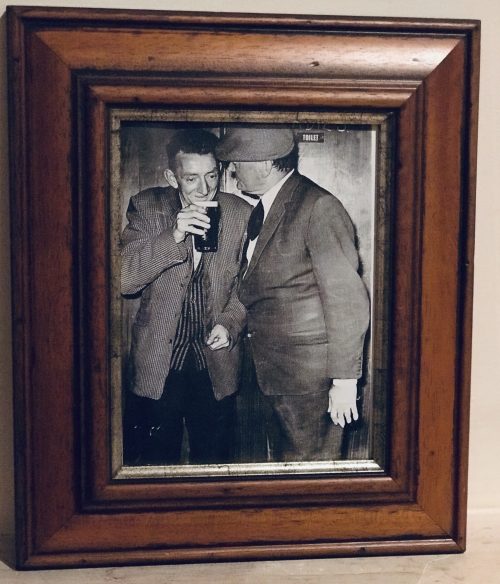

 Tom Moloughney, Jimmy Doyle, and Kieran Carey relax in the dressing room after Tipperary’s victory over Dublin in the 1961 All-Ireland final, a success that was to be repeated the following year. Picture from ‘The GAA — A People’s History’
Tom Moloughney, Jimmy Doyle, and Kieran Carey relax in the dressing room after Tipperary’s victory over Dublin in the 1961 All-Ireland final, a success that was to be repeated the following year. Picture from ‘The GAA — A People’s History’














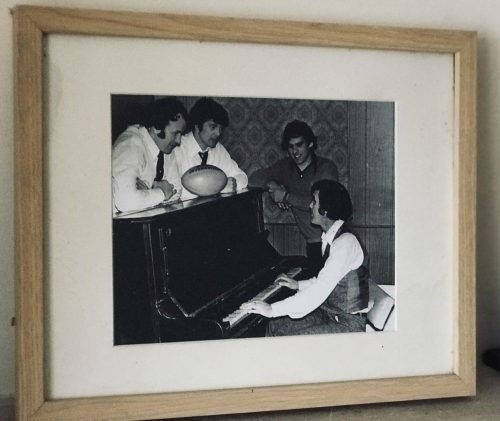

 Many years on, Stuart Wilson vividly recalled the Dennison tackles and spoke about them in remarkable detail and with commendable honesty: “The move involved me coming in from the blind side wing and it had been working very well on tour. It was a workable move and it was paying off so we just kept rolling it out. Against Munster, the gap opened up brilliantly as it was supposed to except that there was this little guy called Seamus Dennison sitting there in front of me.
“He just basically smacked the living daylights out of me. I dusted myself off and thought, I don’t want to have to do that again. Ten minutes later, we called the same move again thinking we’d change it slightly but, no, it didn’t work and I got hammered again.”
The game was 11 minutes old when the most famous try in the history of Munster rugby was scored.
Tom Kiernan recalled: “It came from a great piece of anticipation by Bowen who in the first place had to run around his man to get to Ward’s kick ahead. He then beat two men and when finally tackled, managed to keep his balance and deliver the ball to Cantillon who went on to score. All of this was evidence of sharpness on Bowen’s part.”
Very soon it would be 9-0. In the first five minutes, a towering garryowen by skipper Canniffe had exposed the vulnerability of the New Zealand rearguard under the high ball. They were to be examined once or twice more but it was from a long range but badly struck penalty attempt by Ward that full-back Brian McKechnie knocked on some 15 yards from his line and close to where Cantillon had touched down a few minutes earlier. You could sense White, Whelan, McLoughlin and co in the front five of the Munster scrum smacking their lips as they settled for the scrum. A quick, straight put-in by Canniffe, a well controlled heel, a smart pass by the scrum-half to Ward and the inevitability of a drop goal. And that’s exactly what happened.
The All Blacks enjoyed the majority of forward possession but the harder they tried, the more they fell into the trap set by the wily Kiernan and so brilliantly carried out by every member of the Munster team.
The tourists might have edged the line-out contest through Andy Haden and Frank Oliver but scrum-half Mark Donaldson endured a miserable afternoon as the Munster forwards poured through and buried him in the Thomond Park turf.
As the minutes passed and the All Blacks became more and more unsure as to what to try next, the Thomond Park hordes chanted “Munster-Munster–Munster” to an ever increasing crescendo until with 12 minutes to go, the noise levels reached deafening proportions.
And then ... a deep, probing kick by Ward put Wilson under further pressure. Eventually, he stumbled over the ball as it crossed the line and nervously conceded a five-metre scrum. The Munster heel was disrupted but the ruck was won, Tucker gained possession and slipped a lovely little pass to Ward whose gifted feet and speed of thought enabled him in a twinkle to drop a goal although surrounded by a swarm of black jerseys. So the game entered its final 10 minutes with the All Blacks needing three scores to win and, of course, that was never going to happen.
Munster knew this, so, too, did the All Blacks. Stu Wilson admitted as much as he explained his part in Wardy’s second drop goal: “Tony Ward banged it down, it bounced a little bit, jigged here, jigged there, and I stumbled, fell over, and all of a sudden the heat was on me. They were good chasers. A kick is a kick — but if you have lots of good chasers on it, they make bad kicks look good. I looked up and realised — I’m not going to run out of here so I just dotted it down. I wasn’t going to run that ball back out at them because five of those mad guys were coming down the track at me and I’m thinking, I’m being hit by these guys all day and I’m looking after my body, thank you. Of course it was a five-yard scrum and Ward banged over another drop goal. That was it, there was the game”.
The final whistle duly sounded with Munster 12 points ahead but the heroes of the hour still had to get off the field and reach the safety of the dressing room. Bodies were embraced, faces were kissed, backs were pummelled, you name it, the gauntlet had to be walked. Even the All Blacks seemed impressed with the sense of joy being released all about them. Andy Haden recalled “the sea of red supporters all over the pitch after the game, you could hardly get off for the wave of celebration that was going on. The whole of Thomond Park glowed in the warmth that someone had put one over on the Blacks.”
Controversially, the All Blacks coach, Jack Gleeson (usually a man capable of accepting the good with the bad and who passed away of cancer within 12 months of the tour), in an unguarded (although possibly misunderstood) moment on the following day, let slip his innermost thoughts on the game.
“We were up against a team of kamikaze tacklers,” he lamented. “We set out on this tour to play 15-man rugby but if teams were to adopt the Munster approach and do all they could to stop the All Blacks from playing an attacking game, then the tour and the game would suffer.”
It was interpreted by the majority of observers as a rare piece of sour grapes from a group who had accepted the defeat in good spirit and it certainly did nothing to diminish Munster respect for the All Blacks and their proud rugby tradition.
Many years on, Stuart Wilson vividly recalled the Dennison tackles and spoke about them in remarkable detail and with commendable honesty: “The move involved me coming in from the blind side wing and it had been working very well on tour. It was a workable move and it was paying off so we just kept rolling it out. Against Munster, the gap opened up brilliantly as it was supposed to except that there was this little guy called Seamus Dennison sitting there in front of me.
“He just basically smacked the living daylights out of me. I dusted myself off and thought, I don’t want to have to do that again. Ten minutes later, we called the same move again thinking we’d change it slightly but, no, it didn’t work and I got hammered again.”
The game was 11 minutes old when the most famous try in the history of Munster rugby was scored.
Tom Kiernan recalled: “It came from a great piece of anticipation by Bowen who in the first place had to run around his man to get to Ward’s kick ahead. He then beat two men and when finally tackled, managed to keep his balance and deliver the ball to Cantillon who went on to score. All of this was evidence of sharpness on Bowen’s part.”
Very soon it would be 9-0. In the first five minutes, a towering garryowen by skipper Canniffe had exposed the vulnerability of the New Zealand rearguard under the high ball. They were to be examined once or twice more but it was from a long range but badly struck penalty attempt by Ward that full-back Brian McKechnie knocked on some 15 yards from his line and close to where Cantillon had touched down a few minutes earlier. You could sense White, Whelan, McLoughlin and co in the front five of the Munster scrum smacking their lips as they settled for the scrum. A quick, straight put-in by Canniffe, a well controlled heel, a smart pass by the scrum-half to Ward and the inevitability of a drop goal. And that’s exactly what happened.
The All Blacks enjoyed the majority of forward possession but the harder they tried, the more they fell into the trap set by the wily Kiernan and so brilliantly carried out by every member of the Munster team.
The tourists might have edged the line-out contest through Andy Haden and Frank Oliver but scrum-half Mark Donaldson endured a miserable afternoon as the Munster forwards poured through and buried him in the Thomond Park turf.
As the minutes passed and the All Blacks became more and more unsure as to what to try next, the Thomond Park hordes chanted “Munster-Munster–Munster” to an ever increasing crescendo until with 12 minutes to go, the noise levels reached deafening proportions.
And then ... a deep, probing kick by Ward put Wilson under further pressure. Eventually, he stumbled over the ball as it crossed the line and nervously conceded a five-metre scrum. The Munster heel was disrupted but the ruck was won, Tucker gained possession and slipped a lovely little pass to Ward whose gifted feet and speed of thought enabled him in a twinkle to drop a goal although surrounded by a swarm of black jerseys. So the game entered its final 10 minutes with the All Blacks needing three scores to win and, of course, that was never going to happen.
Munster knew this, so, too, did the All Blacks. Stu Wilson admitted as much as he explained his part in Wardy’s second drop goal: “Tony Ward banged it down, it bounced a little bit, jigged here, jigged there, and I stumbled, fell over, and all of a sudden the heat was on me. They were good chasers. A kick is a kick — but if you have lots of good chasers on it, they make bad kicks look good. I looked up and realised — I’m not going to run out of here so I just dotted it down. I wasn’t going to run that ball back out at them because five of those mad guys were coming down the track at me and I’m thinking, I’m being hit by these guys all day and I’m looking after my body, thank you. Of course it was a five-yard scrum and Ward banged over another drop goal. That was it, there was the game”.
The final whistle duly sounded with Munster 12 points ahead but the heroes of the hour still had to get off the field and reach the safety of the dressing room. Bodies were embraced, faces were kissed, backs were pummelled, you name it, the gauntlet had to be walked. Even the All Blacks seemed impressed with the sense of joy being released all about them. Andy Haden recalled “the sea of red supporters all over the pitch after the game, you could hardly get off for the wave of celebration that was going on. The whole of Thomond Park glowed in the warmth that someone had put one over on the Blacks.”
Controversially, the All Blacks coach, Jack Gleeson (usually a man capable of accepting the good with the bad and who passed away of cancer within 12 months of the tour), in an unguarded (although possibly misunderstood) moment on the following day, let slip his innermost thoughts on the game.
“We were up against a team of kamikaze tacklers,” he lamented. “We set out on this tour to play 15-man rugby but if teams were to adopt the Munster approach and do all they could to stop the All Blacks from playing an attacking game, then the tour and the game would suffer.”
It was interpreted by the majority of observers as a rare piece of sour grapes from a group who had accepted the defeat in good spirit and it certainly did nothing to diminish Munster respect for the All Blacks and their proud rugby tradition.
